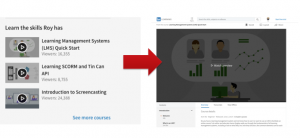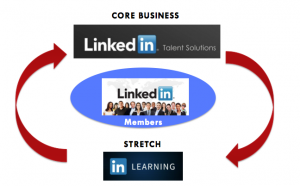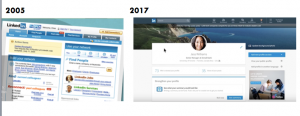Linked In stretch to grow their core
Whilst using Linked In today a new feature caught my eye and got me thinking about how smart the company’s brand stretching has been. The feature suggested skills possessed by the person whose profile I was looking at that I might want to learn. Clicking on the link took me to a relatively new service: Linked In Learning, which was created by the 2015 aqusisiton of elearning business Lynda.com. Clever eh?
Below we look at what we can learn from Linked In’s brand stretching, which is helping the company continue to deliver impressive growth: revenue was up 23% to $959million in Q3 of 2016, according to this report.

1. Build from a strong core
A strong core business is key for successful brand stretching. First, it is your most important source of profit. Second, it is your source of authority, creating imagery and competences you can leverage in new markets. At the heart of the Linked In business model is the membership, which has grown to now be close to half a billion people. One impressive thing about Linked In is how quickly the company was able to ‘monetise’ this user base. Linked In Jobs was launched in 2005, only a year after launch, charging companies to tap into search the member data base for new hires. By 2006 the company was already profitable. This service is now called Linked In Talent Solutions, and is the core business, accounting for 58% of company revenue (Q3 2016). Additional sources of revenue come from further monetising the membership base: advertising, called ‘Marketing Solutions’, is (26% of revenue) and charging for Premium membership to get extra features (18% of revenue).
2. Stretch to grow the core
People often talk about the brand image benefits of brand stretching, sometimes called the ‘halo effect’. However, we encourage clients to consider these benefits as ‘the cherry on the cake’; the real focus should be on the business building benefits. The first and most obvious is the revenue stream from the new product itself. Linked In Learning is adding extra revenue, with learning/development’s $67million of sales in Q3 2016 accounting for 7% of revenue. This part of the business is also the fastest growing, with sales up 63% vs. year ago.
But the best brand stretch initiatives do more than just add extra revenue; they actually drive growth on the core business. And this is the real magic of Linked In Learning. By offering 9,000+ online training courses, the brand can pro-actively enhance the skills-base of its membership. This has a ‘double whammy effect’: more people want to join Linked In to get access to learning offer, either paying for the learning part it as a stand-alone offer, or by taking out a Premium subscription. Second, the site becomes more attractive for employers, as they have access to a better qualified talent pool.

3. Renovate the core
At the same time as stretching to launch new services, Linked In has also continued to renovate the core, as great businesses do. Earlier in 2017 a new site design was introduced, as reported here. This had a sleeker look and feel and some useful new features including:
- Greater insight into who’s viewing your content: see who’s reading and engaging with the content you share
- Better suggestions to make your profile stand out: see more easily what you need to do to look your best professionally e.g. suggested skills based on what recruiters are searching for.
- More intuitive search: one universal search box to easily find people, jobs, companies, groups and schools
The site has come a long way since its early days, as you can see below.

In conclusion, Linked In is a great example of how to stretch your brand in order to actively grow your core business, not just deliver image benefits. This has driven strong growth for the company, and enabled it to keep delivering more on its brand purpose of ‘Connecting the world’s professionals to make them more productive and successful.’


